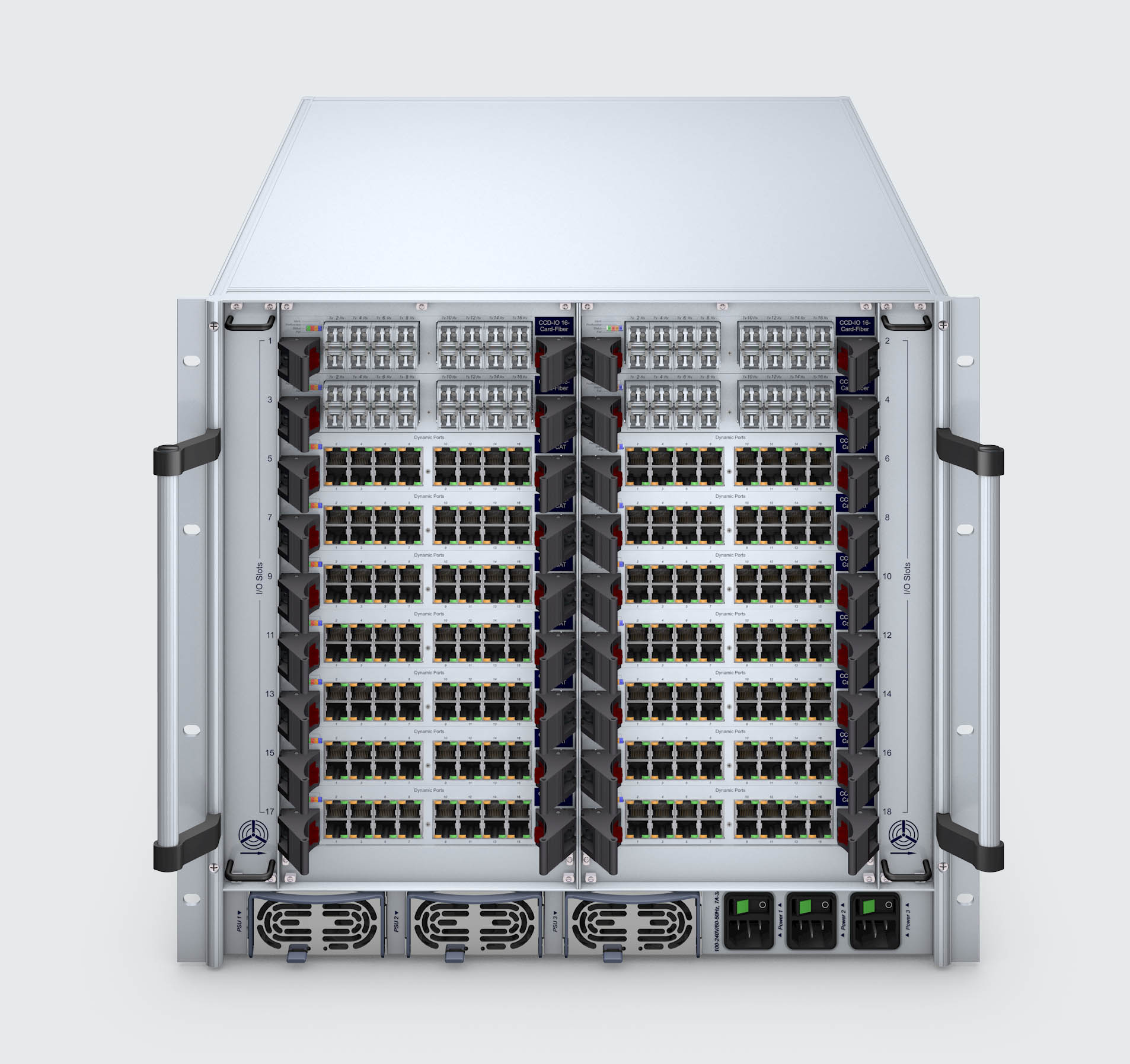
Deeply rooted in the Pro AV industry, KVM systems provide an ideal basis for the flexible, distributed switching of computer signals. They are used very successfully in control rooms and numerous other areas. For years, AV and IT applications have been merging more and more. KVM systems offer an excellent basis for operating various heterogeneous systems on a homogeneous user platform and thus gradually become the backbone of the entire IT infrastructure.
Generally, we distinguish between classic KVM systems and KVM-over-IP. The distinguishing criterion is the choice of transmission technology.
Are the signals transmitted directly, dedicated (proprietary) between the modules, or would you like to use an existing network for this purpose? And what technology is the better choice for your application? What are the differences, benefits, and challenges, and what should you be looking for when choosing a KVM system for your project?

With KVM systems, computers can be removed from the operators’ working environment, such as a control room, and housed in access-protected and air-conditioned areas. From the equipment room, fiber optics, CAT cables, or IP structures extend the computer signals back to the workplace.
KVM also allows users to be separated from each other by enabling them to work on other premises, while still getting full access to all the systems they need. Thanks to KVM, operators have uniform access to the most diverse systems.
The Video Signal
The most important difference between classic KVM and KVM-over-IP is the type of connection technology. Classic KVM uses dedicated cabling, meaning that a dedicated network is usually set up for these systems. This way, the available bandwidth can be optimally utilized without other network-capable devices taking up bandwidth for themselves. Operators benefit from optimum performance combined with the best possible image quality and a perfect user experience.
Plus, thanks to the standard connection technology, already existing in-house cabling can often still be used or even extended. Classic KVM systems also ensure fully secure access because of the complete control of the transmission medium.
Whether you use classic KVM or KVM-over-IP, systems must be adaptable and scalable to ensure a safe investment for the future.
One of the most important requirements for every KVM transmission, whether classic or over IP, is the video quality. The transmission of video signals must be pixel-perfect and as latency-free as possible, with high performance and without sharpness reduction.
The most important difference between the various classic systems lies in the video transmission. Some systems transmit the available information precisely and in real time. Here, transmission takes place uncompressed. Uncompressed KVM extender systems work as a kind of transparent intermediary between computer and workplace: Incoming information is output unaltered at the other end.
Uncompressing systems require a high bandwidth to transmit the incoming video signals from the computer's graphics card to the monitor. Transmission is precise, transparent, and absolutely lossless. However, a higher video resolution also requires a higher bandwidth, which in turn can only be provided by a more powerful, more expensive system.
[Future Proof Control Room Connectivity]
Classic, compressing KVM systems guarantee very high video quality thanks to their video compression, but also offer numerous other advantages. By compressing video signals, the systems require a lower bandwidth and allow for more cost-effective components. In addition, the matrix compatibility makes it easy to expand the systems quickly and easily at a later point. Due to the usually simpler cabling, they are often also more flexible in their application.
Especially in control rooms where uncompromising image quality, pixel perfection, and latency-free operation are essential, uncompressed systems or a pixel-perfect compression offer users significant advantages and a much better visual result compared to other “visually lossless” compression methods.
IP-Based System Basics
IP-based KVM systems have been gaining in importance for years. Many AV applications benefit greatly from the use of IP. Using existing cabling, switches, and routers not only saves costs, but also provides operators and administrators with flexibility and ease of use. Almost all components are plug-and-play devices, making it even easier and more comfortable to install and operate the system.
In addition, IP networks are becoming more and more powerful. Control rooms designing their network infrastructure for 10 Gbit, 40 Gbit, or even 100 Gbit bandwidth are no longer an exception. This means there is usually sufficient bandwidth to easily scale IT installations and implement them over IP.
Transmission is compressed and IP-based over Ethernet networks. For existing infrastructures with a smaller bandwidth, several KVM devices can be bundled, depending on the application requirements. Here, the bandwidth per route can be reduced to approximately 300-500 Mbit. So, even a network with limited uplinks based on 1 Gbit can be sufficient to operate small KVM installations over IP.
Another advantage of IP-supported structures are duplex-capable IP networks. Therefore, the cabling can be used in both directions when transmitting KVM packets. This provides further flexibility, so cabling can be saved in cross-building installations, for example.
Security Concerns
Especially with KVM-over-IP, the issue of security is essential. Access to a network from the outside via the internet or, even easier, from the inside poses a risk. Using the appropriate software or operating systems, it is possible to scan the entire internal network for security holes.
[Cloud Power: What You Need to Know About Security in the Cloud]
Usually, such an attack is targeted at the weakest link in the chain. These can be so-called "man-in-the-middle" attacks, for example, where the entire network traffic is forwarded to a third party. Therefore, separating and segmenting networks is an important tool to protect the actual application from cyberattacks.
In KVM-over-IP systems, keyboard and mouse data, as well as audio and video data, must also be encrypted to prevent unauthorized users from tapping data transmissions and thus gaining access to internal information.
Especially for system-critical applications, the use of VPN, VLANs, and secure encryption is necessary to avoid unauthorized access. Here, input data, primarily from keystrokes (such as logins and passwords), is critical. Secure encryption and regularly exchanging the security key at the shortest possible intervals so that it cannot be read out over time are absolutely essential.
Make Your Choice
KVM-over-IP provides an optimal basis for flexible, distributed switching of computer signals, and facilitates the spatial separation between users and servers. It also allows users to be separated from each other by enabling them to easily work in other locations, while still giving them full access to all the systems they need. Thus, operators can use KVM technology to access their remote computers and work in real time and at full performance.

Whether you use KVM-over-IP or classic KVM, systems must be adaptable and scalable to ensure a safe investment for the future. Only in this way they can adapt to changing conditions and be expanded as the system architecture grows.
KVM-over-IP offers many opportunities to organize work and workflows in a resource-saving and cost-efficient way. The technology enables flexible, reliable, and highly secure infrastructures, creating user-friendly systems that are intuitive to use and easily scalable as needed.
It is simply not possible to generally recommend one or the other, because each project is based on individual requirements and framework conditions. Classic KVM has its own advantages and is still a good choice for many projects. But depending on the application, it may be worth comparing classic KVM systems with KVM-over-IP.
!["[T]he First and Fifth Amendments Require ICE to Provide Information About the Whereabouts of a Detained Person"](https://images.inkl.com/s3/publisher/cover/212/reason-cover.png?w=600)






